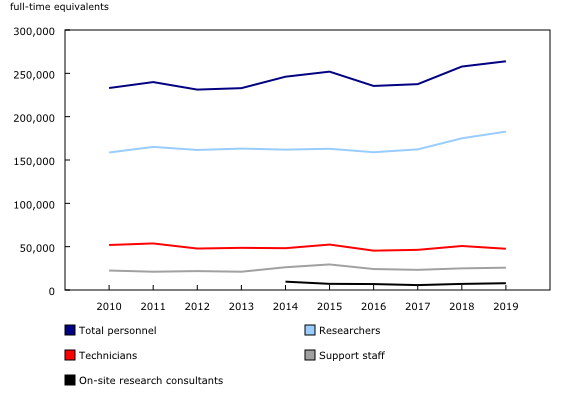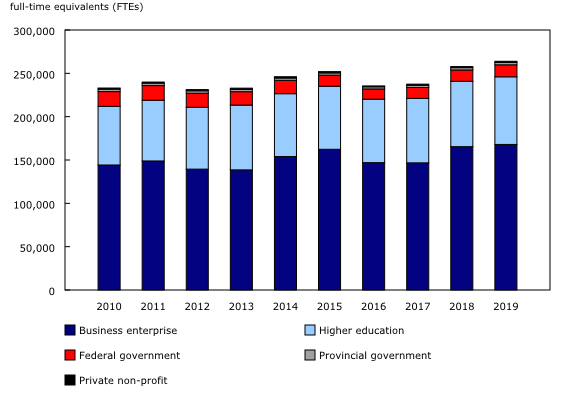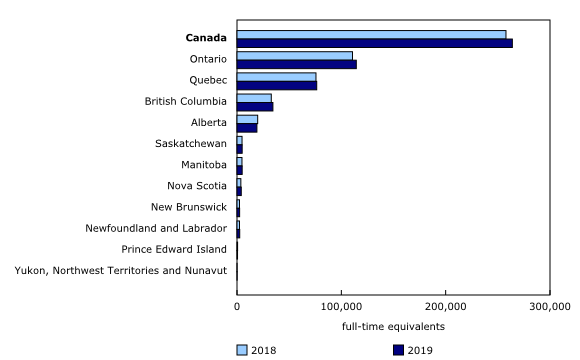Research and development personnel, 2019
Archived Content
Information identified as archived is provided for reference, research or recordkeeping purposes. It is not subject to the Government of Canada Web Standards and has not been altered or updated since it was archived. Please "contact us" to request a format other than those available.
Released: 2022-03-25
263,910 full-time equivalents
2019
+6,100 full-time equivalents 
(year-over-year change)
Canada's research and development (R&D) expenditures have risen steadily in recent years, driven mainly by increased spending from businesses and higher education institutions. Key factors in this growth, however, are the contributions and commitments from employees.
In 2019, the total number of personnel engaged in R&D in Canada rose 2.4% from the previous year to 263,910 full-time equivalents (FTEs). The gain was the result of a 4.4% increase in the number of researchers, whose ranks swelled to 182,760 FTEs.
Research and development as a profession continues to grow
R&D personnel rose in all occupational categories in 2019, except for technicians, which declined after two consecutive years of growth. Researchers continued to be the dominant occupational category in 2019, accounting for almost 7 in 10 employees.
Businesses and the higher education sector are key research and development employers
The business enterprise sector continued to be the largest employer of R&D personnel in Canada in 2019, accounting for 63.6% of all FTEs. Compared with 2018, the number of employees rose 1.5% to 167,960 FTEs. The increase was driven by a gain in the number of researchers (+4,880 FTEs to 110,490 FTEs), which was also the largest occupation category within the sector. Partially offsetting the gain was a decline in the number of technicians (-3,410 FTEs to 35,550 FTEs).
The higher education sector was the second-largest employer of R&D personnel in 2019, representing about 30% of all FTEs. Compared with the previous year, FTEs rose by 2,650 to 78,030 FTEs. An uptick in the number of researchers was behind this gain.
Nearly three-quarters of research and development personnel work in Ontario and Quebec
R&D personnel levels rose in most provinces and territories in 2019, with the exception of Alberta (-3.8% to 19,090 FTEs) and Prince Edward Island (-12.3% to 500 FTEs). Ontario had the highest increase (+3,650 to 114,340 FTEs), followed by British Columbia (+1,530 to 34,400 FTEs) and Quebec (+740 to 76,420 FTEs).
Looking at the spread of R&D personnel across Canada in 2019, Ontario had the highest proportion at 43.3%, followed by Quebec (29.0%) and British Columbia (13.0%).
Sustainable development goals
On January 1, 2016, the world officially began implementation of the 2030 Agenda for Sustainable Development—the United Nations' transformative plan of action that addresses urgent global challenges over the next 15 years. The plan is based on 17 specific sustainable development goals.
Providing data on research and development personnel is an example of how Statistics Canada supports the reporting on the global sustainable development goals. This release will be used to help measure the following goal:

Note to readers
Research and development (R&D) personnel counts are rounded to the nearest 10 and reported as full-time equivalents. Full-time equivalent is a measure of the time actually devoted to R&D. An employee who is engaged in R&D for half a year has a full-time equivalence of 0.5.
R&D personnel encompasses a variety of occupations that are classified into three categories according to their R&D function (Frascati Manual 2015): researchers, technicians and support staff.
Researchers are professionals engaged in the conception or creation of new knowledge. They conduct research and improve or develop concepts, models and methods. Managers and administrators who plan and manage the scientific and technical aspects of a researcher's work, as well as graduate students, are also included.
Technicians and equivalent staff perform scientific and technical tasks involving the application of concepts and operational methods in one or more fields of natural sciences and engineering or social sciences, humanities and the arts, normally under the supervision of researchers.
Support staff includes skilled and unskilled craftspeople, and administrative, secretarial and clerical staff directly associated with R&D projects.
On-site research consultants represent self-employed individuals or contractors who work on the site of the R&D performer and contribute to their intramural R&D. While on-site research consultants are not considered part of the performer's intramural R&D personnel, the Organisation for Economic Co-operation and Development has directed countries to include these consultants as part of total R&D personnel.
Beginning with 2014 data, the business enterprise R&D sector's statistical program concepts and methodology were redesigned. Users should therefore exercise caution when comparing data from 2014 onwards with historical datasets. Documentation on this methodology can be found on the Research and Development in Canadian Industry (changes to the survey for reference year 2014) page of our website.
There are five performing sectors in Canada's R&D personnel release: business enterprise, private non-profit, higher education, federal government and provincial government (which includes provincial research organizations).
Contact information
For more information, or to enquire about the concepts, methods or data quality of this release, contact us (toll-free 1-800-263-1136; 514-283-8300; infostats@statcan.gc.ca) or Media Relations (statcan.mediahotline-ligneinfomedias.statcan@statcan.gc.ca).
- Date modified:




